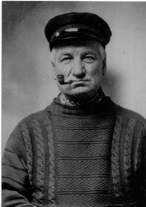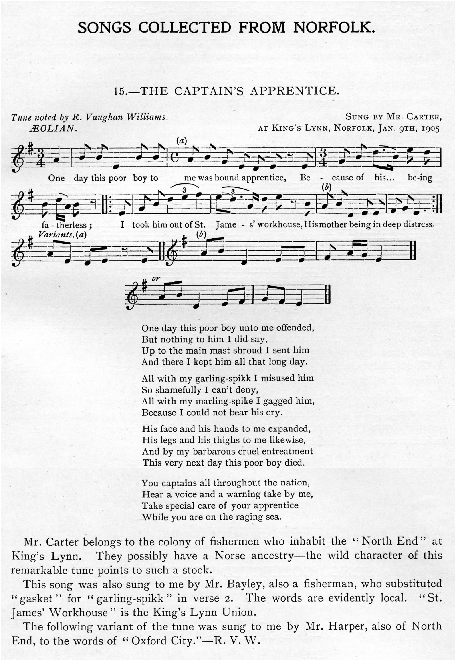by Katie Howson
Behind the Songs No. 1 – Peter the Paynter
John Howson collected this unusual song from Roy Last of Mendlesham Green. The village is featured in the EATMT series of articles “Portrait of a Village” and Roy himself was the subject of our “Personal Portrait†no. 22. This article can now be found on our Musicians Profiles Page HERE.
Roy learned this song, which he called “Peter the Paynter†(and confirmed this spelling) from an auntie in Walsham-le-Willows, who had collected some song sheets (â€broadsidesâ€) in an exercise book. The broadsheets were probably brought to the village by an itinerant ballad-seller, and usually cost a penny each. Sometimes tunes were suggested, but often it was just the words that were given, but they were always intended to be sung!
Some years ago, I was fortunate enough to have a wonderful year on secondment from my teaching job to work in the Suffolk Record Office as education assistant for primary schools. Part of what I did was produce a resource for schools based on Suffolk folk songs, with historical documents and photographs as background (â€From the Horse’s Mouthâ€, long since out of print, but some of the material is to be incorporated in a new publication from Suffolk County Council’s Music Services department).
Whilst digging around in boxes of ephemera, my boss and inspiration, Clive Paine, pointed out a broadside that I had not noticed previously, and a song of Roy’s, that had, until then, seemed to be no more than a story, turned out to be a partial narrative of an actual event that took place just outside Bury St Edmunds in 1844.
The following fragment was all that Roy remembered from his auntie’s book:
“Twas at the town of Bury they quickly broke the news:
Paynter he had broken gaol and left behind his shoes.
Now the ditches they were not too wide and the gates not too high,
And over them, just like a buck, poor Paynter he did fly.
Now run and jump as well he might, ‘twas all of no avail:
He was run to ground at Rougham and brought back to Bury gaol.â€
The original broadside. together with newspaper articles from the time, revealed that the man was actually Leach Borley, commonly known as “Painter†Borley, a farmworker who lived in Sapiston and worked at Rymer Point farm in Troston.
At the time of his escape (from a prison van) he was awaiting trial for arson – a common form of rebellion and protest against changing working conditions and poverty in that period – and was sentenced to transportation. Borley was well-known as a fast runner and had special running shoes (“ankle-jacksâ€) made for him which proved to be vital evidence in identifying him.
The last verse of the broadside, printed by Birchinalls of Bury St Edmunds, has a rather admiring tone and a request showing without doubt where the writer’s sympathies lay:
“He is an active young man, it’s known to be true,
He done his work so clever when he bid them all adieu,
Then a proclamation from the Queen there surely ought to be,
Publish’d in the papers for to set poor Painter free.â€
You can hear Peter the Paynter sung by Roy on Veteran CD “Who Owns the Game?” VT130CD.
Behind the Songs No. 2 – The Captain’s Apprentice
In January 1905, on his first visit to collect folksongs in King’s Lynn, the composer Ralph Vaughan Williams noted down this song from James “Duggie†Carter (below), a fisherman who lived in the tightly-knit North End of the town.

James “Duggie” Carter, King’s Lynn (courtesy of True’s Yard Fishing Heritage Museum) 
Vaughan Williams was very much taken with the melody of the song, a ‘remarkable tune’ with a ‘wild character’ that inspired his own composition Norfolk Rhapsody.
Vaughan Williams commented, ‘The ballad was probably called forth by a particularly brutal case of ill treatment, similar to that narrated in it, which occurred some twenty or thirty years ago.’ No other supporting evidence was found until 1997, when an article from the Lynn Advertiser of 1857 was unearthed, reporting a case of an ex-workhouse inmate, 15 year old Robert Eastick, a cabin boy who died on board the Lynn-owned barque the John Sugars.
The events were so close to those narrated in The Captain’s Apprentice that it easy to see why people believed that the song was written about those specific happenings.
However, further research by Lynn historian Elizabeth James has proved that the song existed before the 1857 events.
A related song, although quite a bit longer, is Captain James, which has been found in log books from American whaling ships from as far as 1768. Although this version has not been found in the UK, there was a whaling connection with King’s Lynn in the nineteenth century.
Another version of the song predating the King’s Lynn events has been found on this side of the Atlantic: a single broadside dating from around 1800 entitled A New Copy of Verses: Made on Captain MILLS, now under confinement in Newgate at Bristol, for the murder of THOMAS BROWN his Apprentice Boy.
As is frequently the case with folk songs, the words have been altered slightly to reflect local events. James also studied the melodies of the different versions and traced similarities between Carter’s rendering and a version of Captain James collected in New Brunswick.
It is not surprising that the song seized the imagination of many people along the Norfolk coast: James Carter had been born in 1844, and so was only 13 and starting out on his own working life at sea when Robert Eastick’s tragic case happened.
He was not the only man to sing it to Vaughan Williams and it was later collected further east along the coast from James Sutton in Winterton (1915) and Harry Cox in Catfield (1921). The song was also collected in Dorset and Somerset, but Carter’s version is the only one where the melody relates to the transatlantic version.
Although folk songs often deal with murders, incest and other dramatic life events, this song has an unusually personal feel to it, perhaps making it a more challenging or distasteful song to choose to sing. The song is rarely heard now, but more recently it has been performed in an innovative yet convincing style by Jim Moray, who has managed to bring out the human drama in the song without undue sensationalism or melodrama.
From the Lynn Advertiser: Lynn, Saturday September 5th (1857)
“CHARGE OF CRUELTY AGAINST A SHIP MASTER
At the Thames Police-office, on Tuesday last, Captain John Doyle, the master of the bark John Sugars, from Ceylon, was charged with various acts of cruelty to a sailor boy named Robert Eastick, who, it was alleged, was driven to commit suicide by the harassing treatment of the captain and the ill-usage exercised towards him. Prince Montague, a man of colour, said he was cook of the John Sugars, now lying in the St Katherine Dock, on her last voyage from Hartlepool to Ceylon and back to London. The deceased, Robert Eastick, shipped at Hartlepool, and was a healthy boy when he came on board, and appeared to be about 15 years of age. He had repeatedly seen the captain ill-use the deceased and flog him with reef points (ropes), with eyes in them, and also kick him and knock him down. The boy had nothing but his blue shirt to protect his back when he was flogged with a rope. The captain also compelled the boy to march up and down the deck like a soldier, with a hand-spike on his shoulder. This punishment was inflicted very often in the evening, after he had done his work. The captain beat the boy very severely with a rope about a cheese that was lost. He had repeatedly heard the boy call out “Murder, murder, save me, save me!†in the cabin while the captain was beating him. One day after the boy was flogged he was crying and upon receiving his dinner said, “Ah cook, this is the last piece of duff (pudding) I shall ever receive from you.†He thought then that the lad was meditating suicide. About a fortnight afterwards the boy was very shamefully beaten by the captain in the cabin and called out “Murder!†and shrieked. He saw the boy’s shoulders and arms, and they were red and blue, and covered with weals. The boy was crying, and said he could not endure it any longer. On the same day the boy came to him in the galley or cook-house on deck with a biscuit, and asked him to pour some hot water upon it for the captain. While he was doing so the boy disappeared. – Mr. Yardley: He vanished that evening from the ship? – Witness: He did, Sir. I heard a cry that the boy was overboard, and he was drowned. – Mr. Walter Pelham said the prisoner, for whom he appeared, had been taken into custody only during the last hour, and was quite unprepared with any defence. He therefore applied that the further investigation should be postponed until Saturday, when he should be ready to cross-examine the witness and enter upon the defence. The magistrate (illegible) and accepted bail for the accused.”
Further information:
Several other musicians/researchers from the region continue to research into Vaughan Williams’ collecting in East Anglia including Katie Howson, Alan Helsdon, and Liz James.
East Anglian Musician and Historian Caroline Davison is currently working on the completion of her book “The Captain’s Apprentice: Biography of a Song” which is due to be published in 2022 to coincide with Vaughan Williams’ 150th anniversary of his birth. You can read more about this project HERE.
For an in depth study of the song and its origins, read: “The Captain’s Apprentice and the Death of Young Robert Eastick of King’s Lynn: a Study in the Development of a Folk Song†by Elizabeth James, Folk Music Journal Vol 7, No. 5, EFDSS, 1999. If you are a member of an academic institution you should be able to read the journal online via the JStor facililty.
Recordings: Jim Moray on the album Skulk (released April 2012).
The Ralph Vaughan Williams Society is in the process of producing 4 volumes of the 80 Folk Songs collected in England by Vaughan Wiliams. The first volume is already available to buy and the second went to production in January 2021. The third volume will contain the Folk Songs collected in the East of England and the Captain’s Apprentice will feature in this volume.
Further instances of the recording and publication of this song: search for song no. 835 in the Roud Folksong Index here.
You can find further information on the research carried out by EATMT for the North End Voices project in 2007 on the website, or you can order a copy of the booklet produced at the end of the project for £3.00 plus £1.00 P&P. (It’s not in our online shop, as it is printed to order. Please email info@eatmt.org.uk to enquire further).
We also have a website page “RVW in the East” which contains further information about our past research.
For background information on King’s Lynn: visit True’s Yard Fishing Museum in King’s Lynn.
Music Image courtesy of EFDSS, from the Journal of the Folk Song Society (1906)